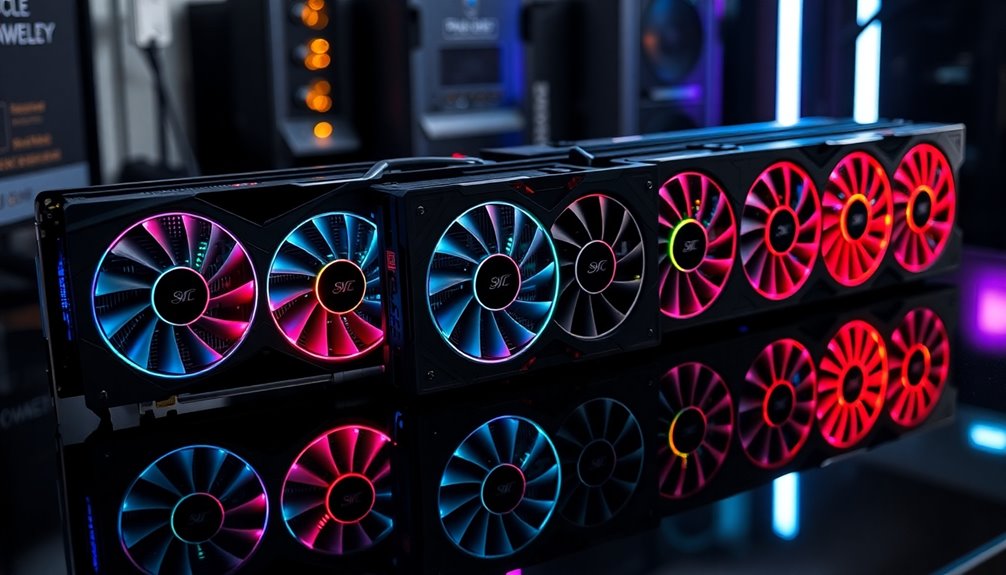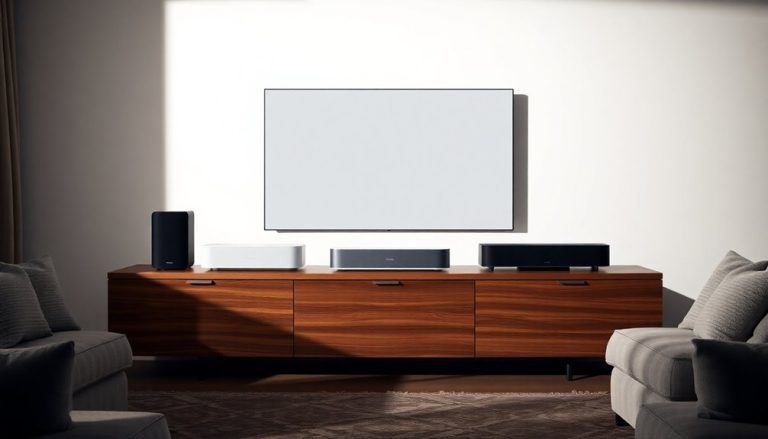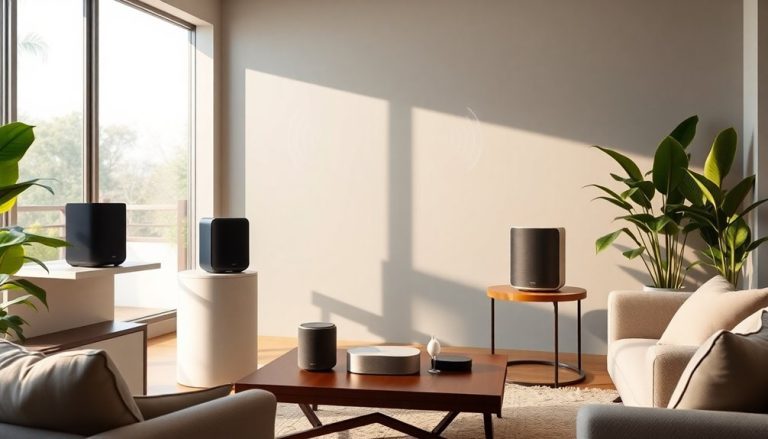In 2025, you'll find graphic cards that push the limits of power and performance. The maxsun AMD Radeon RX 550 is budget-friendly, perfect for 1080p gaming. For higher performance, the GIGABYTE Radeon RX 7600 XT excels in 1080p and 1440p gaming. If you're aiming for stunning visuals, the MSI GeForce RTX 3060 delivers ray tracing capabilities. Meanwhile, the ASUS Prime GeForce RTX 4070 Ti offers impressive frame rates at max settings. Lastly, the ASUS Dual NVIDIA GeForce RTX 3050 combines value with high-resolution support. Stick around to explore what makes these cards stand out even more!
Key Takeaways
- Advanced Graphics Technology: Look for GPUs featuring cutting-edge architectures, such as NVIDIA's Ampere or future generations, for superior performance and efficiency.
- Memory Size: Opt for graphics cards with at least 8GB of GDDR6 memory to ensure smooth gameplay at 1440p and 4K resolutions.
- Cooling Solutions: Choose models with effective cooling systems, like dual or triple-fan setups, to maintain performance during intense gaming sessions.
- Power Supply Compatibility: Ensure your power supply meets the minimum wattage and connector requirements for each graphics card to avoid performance issues.
- Future-Proofing: Consider cards that support high resolutions and advanced features like ray tracing and DLSS for longevity in gaming performance.
maxsun AMD Radeon RX 550 4GB GDDR5 Graphics Card
maxsun AMD Radeon RX 550 4GB GDDR5 ITX Computer PC Gaming Video Graphics Card GPU 128-Bit DirectX 12 PCI Express X16 3.0 DVI-D Dual Link, HDMI, DisplayPort
$93.99 (as of November 12, 2025 06:51 GMT +00:00 - More infoProduct prices and availability are accurate as of the date/time indicated and are subject to change. Any price and availability information displayed on [relevant Amazon Site(s), as applicable] at the time of purchase will apply to the purchase of this product.)If you're looking for a budget-friendly option that excels in 1080p gaming and multimedia tasks, the maxsun AMD Radeon RX 550 4GB GDDR5 Graphics Card is a solid choice. With a compact ITX design, it fits easily into smaller systems, making it perfect for tight spaces. The 4GB GDDR5 memory and a boost clock of up to 1183 MHz ensure smooth performance for moderate gaming and everyday tasks. Plus, its low power consumption means you can run it efficiently on a 400W power supply. While it supports resolutions up to 8K, you might face limitations with newer games or applications. However, for budget-conscious gamers, its low noise and easy installation make it a worthwhile consideration.
Best For: Budget-conscious gamers seeking a reliable graphics card for 1080p gaming and multimedia tasks in compact systems.
Pros:
- Low power consumption, allowing efficient operation on a 400W power supply.
- Compact ITX design fits easily into smaller PC cases, perfect for limited space.
- Silent operation thanks to the 9CM unique fan, providing high airflow with low noise.
Cons:
- Performance limitations may struggle with newer, demanding games and applications.
- Potential compatibility issues with certain systems and driver conflicts after Windows updates.
- Limited connectivity options (HDMI, DVI, DisplayPort) may not satisfy all users' needs.
GIGABYTE Radeon RX 7600 XT Gaming OC 16G Graphics Card
GIGABYTE Radeon RX 7600 XT Gaming OC 16G Graphics Card, 3X WINDFORCE Fans 16GB 128-bit GDDR6, GV-R76XTGAMING OC-16GD Video Card
The GIGABYTE Radeon RX 7600 XT Gaming OC 16G graphics card is an excellent choice for gamers seeking high performance at 1080p and 1440p resolutions. With 16GB of GDDR6 memory and a 128-bit memory interface, it delivers impressive speeds, hitting over 100 FPS in Battlefield 5 at ultra settings. The WINDFORCE cooling system ensures efficient heat management, while the RGB Fusion adds a touch of flair to your setup. Connectivity options include HDMI 2.1a and DisplayPort 2.1, making it versatile for modern displays. Weighing just 2.77 pounds, it's easy to install. User reviews highlight its performance and aesthetics, although some noted installation challenges. Overall, it's a solid upgrade for those moving from older models.
Best For: Gamers looking for high-performance graphics for 1080p and 1440p gaming experiences.
Pros:
- Excellent performance with over 100 FPS in demanding games like Battlefield 5 at ultra settings.
- Equipped with 16GB GDDR6 memory and a robust WINDFORCE cooling system for efficient heat management.
- Versatile connectivity options including HDMI 2.1a and DisplayPort 2.1, suitable for modern displays.
Cons:
- Some users reported installation difficulties and occasional crashes.
- May require a compatible 600W power supply, which could be a limitation for some setups.
- Limited warranty and return policy after 30 days may pose risks for potential buyers.
MSI GeForce RTX 3060 Gaming Graphics Card
MSI GeForce RTX 3060 Ventus 2X 12G OC, Gaming Graphics Card - NVIDIA RTX 3060, 12GB GDDR6 Memory, 192-bit, 15 Gbps
12% OffFor gamers seeking high performance without breaking the bank, the MSI GeForce RTX 3060 Gaming Graphics Card stands out as an exceptional choice in 2025. With its NVIDIA Ampere architecture and 12GB of GDDR6 memory, it delivers impressive graphics capabilities, supporting ray tracing and DLSS for stunning visuals. You'll appreciate the dual-fan cooling system that operates quietly while keeping temperatures in check. This card can handle max screen resolutions up to 7680×4320 pixels, making it perfect for high-res gaming. Plus, its award-winning MSI TORX Fan 3.0 design ensures effective airflow. With a solid customer rating of 4.6 out of 5 stars, it's a top contender, especially when paired with a good CPU and ample storage.
Best For: Gamers looking for a high-performance graphics card that offers excellent value without exceeding their budget.
Pros:
- Strong performance with NVIDIA Ampere architecture, perfect for gaming and content creation.
- Supports ray tracing and DLSS, providing stunning visuals and enhanced frame rates.
- Quiet dual-fan cooling system with award-winning TORX Fan 3.0 design for effective airflow.
Cons:
- Limited availability may lead to inflated prices in some markets.
- May require a powerful CPU and sufficient storage for optimal performance.
- Size constraints could limit compatibility with smaller PC cases.
ASUS Prime GeForce RTX 4070 Ti Super OC Edition Graphics Card
ASUS The SFF-Ready Prime GeForce RTX™ 4070 Ti Super OC Edition 16GB GDDR6X Graphics Card (PCIe® 4.0, 16GB GDDR6X, DLSS 3, HDMI 2.1a, DisplayPort™ 1.4a)
20% OffLooking to elevate your gaming experience? The ASUS Prime GeForce RTX 4070 Ti Super OC Edition is your ticket to stunning visuals and unmatched performance. With 16GB of GDDR6X memory and a PCIe 4.0 interface, it handles the latest games with ease, delivering high FPS ranging from 80 to 150 on max settings. Featuring NVIDIA's DLSS 3 and advanced ray tracing capabilities, you'll enjoy breathtaking graphics that push the boundaries of realism. Its compact design fits seamlessly into small-form-factor builds, while the triple-fan setup ensures efficient cooling with minimal noise. Weighing just 2.3 pounds, it's a lightweight powerhouse ready to transform your gaming setup. Experience smooth gameplay in titles like Cyberpunk and MSFS 2020 with this exceptional card.
Best For: Gamers seeking high-performance graphics and stunning visuals in a compact design for small-form-factor builds.
Pros:
- High FPS performance: Achieves 80 to 150 FPS on max graphics settings for an immersive gaming experience.
- Quiet operation: Features a triple-fan setup that minimizes noise while ensuring efficient cooling.
- Seamless integration: Compact design fits well within small-form-factor builds and the ASUS PRIME ecosystem.
Cons:
- Weight: At 2.3 pounds, it may be heavier than some other compact graphics options.
- Availability: Released on October 14, 2024, may limit immediate access for some users.
- Price point: High-performance features may come at a premium compared to lower-tier alternatives.
ASUS Dual NVIDIA GeForce RTX 3050 Gaming Graphics Card
ASUS Dual NVIDIA GeForce RTX 3050 6GB OC Edition Gaming Graphics Card - PCIe 4.0, 6GB GDDR6 Memory, HDMI 2.1, DisplayPort 1.4a, 2-Slot Design, Axial-tech Fan Design, 0dB Technology, Steel Bracket
$199.99 (as of November 12, 2025 06:51 GMT +00:00 - More infoProduct prices and availability are accurate as of the date/time indicated and are subject to change. Any price and availability information displayed on [relevant Amazon Site(s), as applicable] at the time of purchase will apply to the purchase of this product.)Gamers on a budget will find the ASUS Dual NVIDIA GeForce RTX 3050 Gaming Graphics Card to be an excellent choice for enjoying modern titles without breaking the bank. With its NVIDIA Ampere architecture and 6GB GDDR6 memory, you'll experience impressive performance and improved power efficiency. The 2nd generation RT cores allow for enhanced ray-tracing, while the 3rd generation Tensor cores boost AI capabilities like DLSS, giving you that extra edge in gaming.
Its cooling features, including two axial-tech fans and a 2-slot design, ensure optimal airflow and temperature management. Plus, with a maximum screen resolution of 7680 x 4320 pixels, you're all set for high-definition gaming. Just remember to check your power cable requirements before installation!
Best For: Budget-conscious gamers seeking solid performance in modern gaming titles without overspending.
Pros:
- Impressive performance with NVIDIA Ampere architecture and 6GB GDDR6 memory.
- Effective cooling with dual axial-tech fans for optimal airflow.
- High-resolution support up to 7680 x 4320 pixels for breathtaking visuals.
Cons:
- Installation may require an 8-Pin power cable, which can be an extra cost or hassle.
- Mixed reviews on stability and performance in demanding applications.
- Potential limitations for users aiming for ultra settings in the latest games.
Factors to Consider When Choosing Graphic Cards
When choosing a graphic card, you need to consider several key factors. Think about your performance and gaming needs, as well as how well the card will fit with your system. Don't forget to check the memory size, cooling solutions, and power supply requirements to ensure a smooth gaming experience.
Performance and Gaming Needs
Choosing the right graphic card can significantly impact your gaming experience, especially as technology advances. Start by determining the required memory size for your gaming needs. For 1080p gaming, 4GB might suffice, but if you're aiming for 1440p or 4K, consider investing in a card with 16GB.
Next, look at the boost clock speed; higher speeds, such as 1183 MHz, can enhance performance in demanding titles. Additionally, pay attention to the number of stream processors. A card with more processors—like 512 in older models—can handle parallel tasks more effectively, providing a smoother gaming experience.
Don't forget to evaluate the supported resolutions. If you want to future-proof your setup, opt for cards that can handle 8K resolution, ensuring they'll perform well with high-resolution displays. Lastly, assess the cooling solutions and noise levels. Effective cooling systems, such as dual-fan setups, help maintain performance under load while minimizing noise during intense gaming sessions.
Compatibility With Systems
Many enthusiasts overlook compatibility when selecting a graphics card, but it's crucial for ensuring optimal performance. First, check that the graphics card's interface matches your motherboard, typically PCIe 4.0 or PCIe 3.0. This compatibility directly impacts installation and overall performance. Next, examine the physical dimensions of the card; it needs to fit snugly within your PC case, especially if you're using a smaller form factor design.
Additionally, don't forget about power supply requirements. Ensure your power supply has enough wattage and the necessary power connectors, like 6-pin or 8-pin, to support the new graphics card. It's also essential to verify compatibility with your operating system. Make sure drivers are available for the graphics card model to prevent installation and performance issues down the line.
Lastly, consider thermal management needs. Some graphics cards may require additional cooling solutions or improved airflow within your case to avoid overheating during intense gaming sessions. By addressing these factors, you can ensure your new graphics card integrates smoothly with your system, providing the best performance possible.
Memory Size and Speed
Memory size and speed are pivotal factors in selecting a graphics card that meets your gaming or professional needs. The memory size, measured in gigabytes (GB), directly affects how much data your card can handle at once. For gaming at high resolutions, especially 4K, you'll want a card with at least 8GB to prevent stuttering and ensure smooth performance. Cards can range from 4GB to 16GB or more, so choose wisely based on your usage.
Speed is equally important. It's measured in megahertz (MHz), determining how quickly the GPU accesses data. For instance, GDDR5 memory operates around 6000 MHz, while GDDR6 can soar to 18000 MHz. Higher speeds translate to better performance, particularly in demanding applications.
Additionally, consider the memory interface width, expressed in bits (like 128-bit or 192-bit). A wider interface means more data can flow between the memory and GPU, enhancing overall performance. When choosing a graphics card, prioritize a combination of ample memory size and high speed to future-proof your setup against increasingly demanding software requirements.
Cooling Solutions Available
Maintaining optimal performance and longevity in your graphics card hinges on effective cooling solutions. When selecting a card, you should consider the cooling design, as it plays a crucial role in maintaining temperatures during demanding tasks like gaming or rendering. Many high-performance models utilize axial-tech fan designs, which incorporate smaller hubs and longer blades to boost air pressure and cooling efficiency.
Look for cards that feature specialized cooling systems, such as heat pipes and large heatsinks, designed to dissipate heat effectively. If minimizing noise is a priority for you, consider models with zero dB technology, which allows fans to stop spinning during low-load situations. This not only reduces noise but also saves power when full cooling isn't necessary.
Moreover, better cooling can significantly impact your card's overclocking potential. Enhanced cooling allows you to push your hardware further without overheating, maximizing frame rates and graphical fidelity in demanding applications. So, when comparing graphic cards, pay close attention to the cooling solutions available; they can make all the difference in performance and overall user experience.
Power Supply Requirements
After you've settled on a graphics card with effective cooling solutions, the next factor to consider is its power supply requirements. Ensure that your power supply unit (PSU) meets the minimum wattage specified by the card—many modern GPUs need at least 400W to operate efficiently. If you're eyeing a graphics card with higher memory capacities, like 16GB, remember that these typically demand more power.
It's also crucial to check the type and number of power connectors the graphics card requires. Some models may need an 8-pin or 6-pin PCIe power connector, so make sure your PSU has the right connectors available.
Don't overlook the efficiency rating of your power supply, either. Higher ratings, such as 80 Plus Bronze or Gold, result in less wasted power and better overall stability and cooling. Finally, aim for a PSU with ample headroom—20-30% above the recommended wattage is ideal. This extra capacity can accommodate power spikes during intensive gaming or rendering, ensuring your graphics card operates smoothly under load.
Budget and Pricing Factors
Setting a clear budget is essential when choosing a graphics card, as prices can range significantly from around $100 for entry-level models to over $1,000 for high-end options. Start by considering the price-to-performance ratio. If you're a budget gamer, options like the Maxsun AMD Radeon RX 550 can deliver decent performance without breaking the bank. However, if you want enhanced performance, the GIGABYTE Radeon RX 7600 XT might be worth the higher price.
Don't forget to monitor market trends and availability. Prices can fluctuate due to demand and supply chain issues, so keep an eye out for potential price hikes on popular models. Also, factor in any additional costs like a compatible power supply and cooling solutions, especially for higher-end cards that require more power and better thermal management.
Lastly, think about long-term value and future-proofing. Investing in a more expensive card today can save you money in the long run by postponing the need for upgrades as gaming and software requirements evolve. Balancing performance, cost, and future needs will help you make a wise decision.
Frequently Asked Questions
What Is the Average Lifespan of a Modern Graphic Card?
The average lifespan of a modern graphic card typically ranges from 3 to 5 years, depending on usage. If you're gaming or running demanding applications, you might want to consider upgrading sooner for optimal performance.
Can I Use Multiple Graphic Cards Together?
Yes, you can use multiple graphic cards together, often referred to as SLI or CrossFire. Just ensure your motherboard supports it and that your power supply can handle the additional load. It'll boost your performance significantly!
How Do I Know if My Power Supply Is Sufficient?
Before you dive in, it's crucial to ensure your power supply can handle your setup. Check the wattage requirements of your components and compare them to your power supply's output—don't get caught short!
What Are the Signs of a Failing Graphic Card?
If you're noticing artifacts, crashes, or unusual behavior during gameplay, your graphic card might be failing. Overheating and poor performance in demanding tasks are also signs you shouldn't ignore. It's time to investigate or replace it.
Are Graphic Cards Compatible With All Motherboards?
Not all graphic cards fit every motherboard like a key in a lock. You need to check compatibility based on PCIe slots, size, and power requirements. Always verify specs before making a purchase to avoid headaches.
Conclusion
In conclusion, choosing the right graphics card can significantly boost your gaming experience and productivity. Did you know that by 2025, over 50% of gamers are expected to upgrade their GPUs to keep up with demanding titles? With options like the ASUS Prime GeForce RTX 4070 Ti and GIGABYTE Radeon RX 7600 XT, you're sure to find the perfect fit for your needs. So, don't hesitate—level up your setup and enjoy the power and performance these cards offer!

































